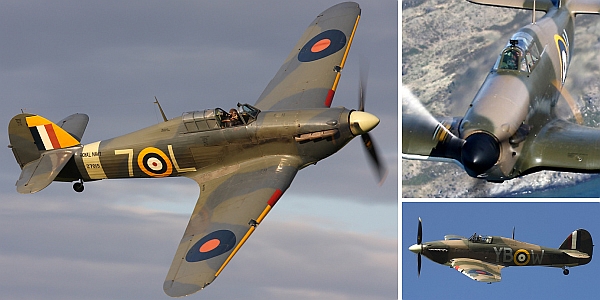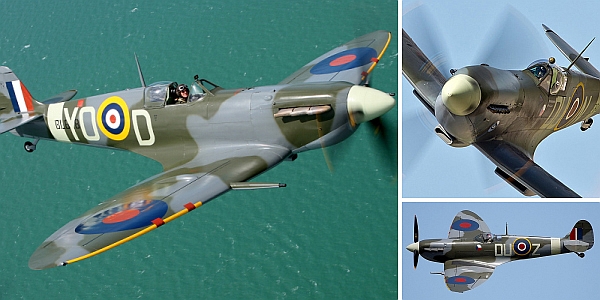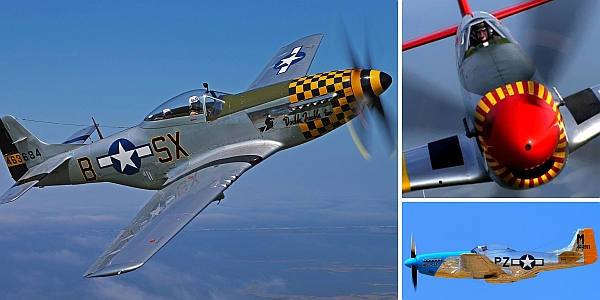
The German air force (the Luftwaffe) was probably the strongest air force in Europe at the dawn of the Second World War. It isn’t surprising – Germany invested a lot in the aircraft development and the military personnel training before starting the war.
After the first bullet of the Second World War was fired, the Allies saw themselves forced to deal with a painful problem – the Luftwaffe, the modern German air force. Experienced pilots, many of them already aces from the Spanish Civil War, flying one of the most advanced aircraft of its time – the Messerschmitt Bf 109 – were ready and eager to win the ultimate victory.
Hawker Hurricane

The Hawker Hurricane prototype took off in 1935 for the first time, and a year later the production began. Designed as an interceptor initially, the Hurricane would soon be outclassed, being quite obsolete at the beginning of the war. Even so, it played an important role in winning the Battle of Britain.
The Hawker Hurricane “was built with the strength of a battleship, had an engine of great power and reliability, and was throughout an excellent and accurate flying machine.” remarked one of the pilots who flew it.
Despite their qualities, the Hurricanes had a major problem with the carbon monoxide that leaked into the cockpit. Nothing solved this issue completely, in spite of the many attempts made to fix it by outfitting the planes with longer exhaust stubs or other adjustments. The only efficient solution was to instruct pilots to keep the oxygen masks on during the flight until the engine has shut down.
LESSER-KNOWN FACTS:
The Soviet Union was one of the main customers that purchased Hawker Hurricanes – nearly 3,000 Hurricanes (more than 20% of the total aircraft produced in the UK). The Hawker Hurricane was, actually, the most numerous British aircraft in the Soviet service.
Hawker Hurricane fought also along the Axis. Before signing the alliance with Germany, Romania bought a number of Hurricanes used later against the Soviets.
Supermarine Spitfire

An iconic figure of the Second World War, the Supermarine Spitfire was the only aircraft that could really rival the German fighters, especially during the Battle of Britain.
The Spitfire design incorporated some very modern features for that time, like the elliptical wings and a retractable landing gear; many new pilots crash landed because they assumed the landing gear was already in position for landing, forgetting to put it down.
It was fast, with a high rate of climb but also very well balanced. ‘Our Spits were so well balanced they would fly themselves. Many pilots owe their lives to this property …. If a pilot passed out through lack of oxygen, the Spitfire would fall away in a dive and correct itself’ remembers one of the Spitfire pilots.
The first Spitfire left the ground on 5 March 1936, and two years later it entered the Royal Air Force service. Being the main British fighter plane, the Supermarine Spitfire was produced during the entire war and remained in service until 1955.
It is said the Luftwaffe pilots themselves praised the qualities of the Supermarine Spitfire. The Battle of Britain wasn’t going very well for Germany, and the commander of the German Luftwaffe during the war, Hermann Göring asked for explanations. During a hot argument on this issue, the ace Adolf Galland gave his superior a stunning reply “I should like an outfit of Spitfires for my group”; a superb compliment the enemy paid to this amazing plane.
LESSER-KNOWN FACTS:
The Supermarine Spitfire has its origins in the Supermarine’s racing floatplanes the Reginald Mitchell’s team designed and built for the Schneider Trophy contest.
Some of the Spitfires had several modifications that allowed the planes to carry under the wings two small barrels of beer, instead of bombs.
P-51 Mustang:

A veteran of World War II and the Korean War, the P-51 Mustang gave Luftwaffe the coup de grâce (the “blow of mercy”). Mustangs met and defeated every German aircraft during the war, starting from the early piston-engined fighters to the advanced, and powerful twin-jet Messerschmitt Me 262.
The North American P-51 Mustang was a very maneuverable plane, with a good controllability, and rate of climb. It posessed an exceptionally good high speed in level flight at all altitudes, but his incredible long range set the Mustang apart from other fighters.
Although first designed as a medium-altitude fighter, the P-51 Mustang did a great job in hedge-hopping strafing runs and as a long-range bomber escort. It became a powerful fighting machine, famous for blasting trains, ships and enemy bases in the Western Europe.
In Italy, the Mustangs pounded the Axis defenses preparing the Allied invasion of Sicily. The impact of the P-51 over the Luftwaffe was so strong that Hermann Göring himself confessed “When I saw Mustangs over Berlin, I knew the jig was up.”
The Luftwaffe had also its own P-51 Mustang squadron. Several Mustangs damaged at landing were captured by Germans who repaired, and used them for testing.
After the war, the P-51 Mustang met the former enemy Messerschmitt Bf 109 within the same air force. It is the state of Israel that managed to purchase some Bf 109G variants made in Czechoslovakia (Avia S.199) and several P-51 Mustangs. Both planes saw action during the Arab-Israeli conflicts.
The Hawker Hurricane, the Supermarine Spitfire and the North American P-51 Mustang are certainly not the only machines that defeated the Luftwaffe. No one can deny, though, they were some wonderful planes that appeared in the right places, at the right time, having the right pilots in their cockpits.
by Marius Bujor, for Scale Model Aircraft – The Modeller’s Aviation DatabaseReprinted with permission on War History Online
References:
- Supermarine Spitfires and Hawker Hurricanes: World War II Aircraft by David Alan Johnson, Aviation History, November 1994
- The Complete Encyclopedia of Flight 1939-1945 by John Batchelor, Malcolm V. Lowe
- The Encyclopedia of Military Aircraft: Over 650 Entires from 1914 to the Present Day by Robert Jackson
- The Illustrated Encyclopedia of Military Aircraft 1914 to the Present by Enzo Angelucci

Δεν υπάρχουν σχόλια:
Δημοσίευση σχολίου